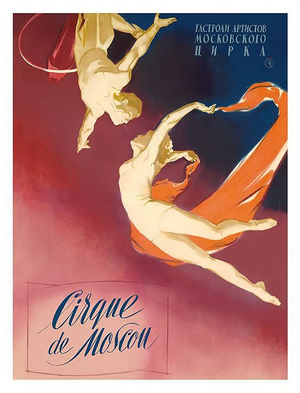Difference between revisions of "Moscow Circus"
From Circopedia
(→Image Gallery) |
(→Image Gallery) |
||
| Line 15: | Line 15: | ||
<Gallery> | <Gallery> | ||
| − | File:Moscow_Circus_1956.jpg|Program of the first Moscow Circus | + | File:Moscow_Circus_1956.jpg|Program of the first Moscow Circus visit to Paris (1956) |
File:Cirque_de_Moscou_poster.jpg|Poster for the Moscow Circus's first visit to Belgium and France (1956) | File:Cirque_de_Moscou_poster.jpg|Poster for the Moscow Circus's first visit to Belgium and France (1956) | ||
File:Popov_in_Paris.jpeg|The Moscow Circus in Paris (1960) | File:Popov_in_Paris.jpeg|The Moscow Circus in Paris (1960) | ||
Latest revision as of 18:13, 29 May 2025
By Dominique Jando
Although there are actually two genuine Moscow circuses, Circus Nikulin—the "Old Circus" on Tsvetnoy Boulevard—and the Bolshoi Circus on Vernadsky Avenue, the title "Moscow Circus" was originally a generic title for the Soviet circus troupes that traveled abroad, in shows produced by the Soviet central circus organization, SoyuzGosTsirk.
The superb artistry, amazing technique, and constant innovation the Soviet circus artists displayed in the Moscow Circus tours led to a much needed change in the public perception of the circus in the West, and its subsequent renaissance in the 1970s. From the first European performance of Oleg Popov in 1956 to the American debut of the Flying Cranes more than three decades later, the Moscow Circus has inspired an entire generation of circus mavericks, who went on to create some of today's most successful circuses. It also inspired many old circus families who tried new approaches to an art they had served sometimes without much imagination for generations.
The fall of the Soviet Union in 1991 saw an exodus of Russian circus artists, who settled all over the world—and even those who stayed in Russia began working independently. Although SoyuzGosTsirk, which had changed changed its name to RosGosTsirk, tried to revive the tours of the Moscow Circus, the economics had changed, and it had become difficult to support the huge traveling troupes of 60 to 100 persons that made the old "Moscow Circus" shows in the Soviet era. Beside, many top Russian acts could be seen in the West, in other circuses and variety shows.
Today, the title "Moscow Circus" has become a commodity—sometimes registered with exclusive rights in a country or another—used to present shows involving Russian performers. Some of these shows have a legitimate reason to be called "Moscow Circus"; others are just using the title as a marketing gimmick, more or less shamelessly. These shows however are rarely a direct emanation of a Russian circus organization, and none of them come even remotely close to the splendor, innovation, and sheer amount of talent once displayed all over the world by the original "Moscow Circus" companies.



